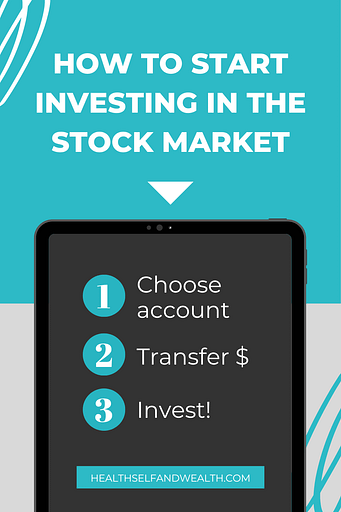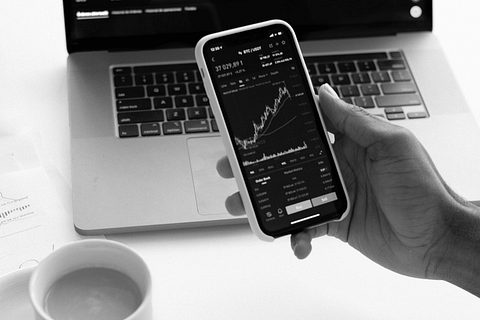
The number one question I get asked is how to start investing in the stock market. Like how to literally hit the buttons online to make an investment.
My ladies are smart. We know we need to invest if we want to live wealth and earn our independence. That’s why you’re here right?
Because the value of money comes from the control it gives us over our own lives.
So let’s learn how to start investing in the stock market, without a financial advisor.
If you were hoping this would be more like a beginner’s guide to investing, check out this index fund investing guide.
Please note I am not a licensed financial advisor. This information is for education purposes only. Every person has a unique financial situation. The best approach will be different for everyone. Accordingly, do your own due diligence before making any financial decision.
1. Choose an investment account
The first step on how to start investing in the stock market begins with an investment account. An investment account is like a savings account, except that you can invest the money in the account and earn more interest.
There are two main types of investment accounts: retirement accounts and brokerage accounts.
Retirement accounts typically come with tax benefits, while a brokerage account doesn’t.
Here’s a list of common investment accounts, in the order I prioritize them.
- 401(k)
- Roth IRA
- HSA
- Brokerage
If you are not sure what investment account you want, here’s a rundown of the pros and cons of the most common investment accounts.
If you choose a 401(k) or HSA, your employer may help you create the account. Go to your HR person if you need help with this.
If you choose an IRA or brokerage account, you will open these yourself, if you don’t have one already.
I use a reputable low cost broker, like Vanguard, Fidelity, Charles Schwab, because they have minimal fees and 24/7 support.
A broker holds your investment account, like your bank holds your savings accounts.
Once you decide what broker to go with, follow the instructions online to create your account.
2. Transfer the money into the account
Once you have your investment account opened, it’s time for step 2 of how to start investing in the stock market: fund your account!
Transfer money into an IRA or brokerage account
On your broker’s website or app, there’s an option to link your bank account. Once your account is linked, then you can transfer your money from your bank account to your investment account. It usually takes 1-2 business days or so.
If you know you want to make regular investments, you can also set up automatic, recurring transfers.
Transfer money into a 401(k) or HSA
Typically you will tell your employer how much to contribute from your paycheck into these investment accounts. It’s also likely you will have to decide what to invest your money in when you open the account.
That means your employer will automate this process for you. I highly recommend keeping a close eye on your investment account at least this first month to ensure your money is being invested as you intended.
3. Buy the investments
If you have your own account, an IRA or brokerage, you aren’t done yet! Step 3 of how to start investing is actually purchasing investments. If you skip this step, you just have cash sitting in an investment account.
Just like any good tiktok dance, there are a couple of moves for this.
First, you must decide what you will invest your money in. Because I am not a financial advisor, I am not qualified to help you with this.
I personally invest in low cost index funds because they tend to have low fees and they tend to outperform alternative investments over the long term. Learn more about index funds here.
Once you decide what you’ll invest your money in, then you’ll place the trade (make the investment just like you were ordering food at Chick-fil-A.)
For the sake of this example, I’m going to invest $100 into a S&P 500 index fund at Vanguard. The first thing you need to know is the ticker symbol (e.g., VFIAX, VOO, etc.) and if it’s a mutual fund or ETF.
Let’s back it up. Index fund, mutual fund, ETF? What’s the difference?
Index Fund
An index fund means that the collection of stocks mirrors an index, like the S&P 500. It can be a mutual fund or an ETF.
All mutual funds, ETFs, and index funds are a collection of assets. For example, the S&P 500 is a stock collection of the 500 biggest companies in the U.S.
The difference between mutual funds and ETFs come from how you trade them.
Mutual fund
With a mutual fund, you place a trade during stock market hours based on a set dollar amount you want to invest. Then after hours, the price of the mutual fund is calculated based on the stock prices of all the companies in the fund.
For example, let’s say you wanted to invest $1000 into an S&P 500 index fund like VFIAX. At the time of writing, it’s priced at $381.57 a share. With mutual funds, you can have fractional shares. That means you’d have 2.62 shares of VFIAX.
You can recognize a mutual fund by a 5 character ticker symbol ending with X, such as VFIAX.
Sometimes mutual funds have a minimum investment.
ETF
An ETF trades like a stock. When you place a trade during stock market hours, the trade can happen immediately. However, most often you cannot have fractional shares.
For example, let’s say you wanted to invest $1000 into an S&P 500 ETF like VOO. At the time of writing, it’s priced at $377.65 a share. You could buy 2 shares to have a total of $755.30 invested.
There’s a little more control and nuance with ETFs. You have to also choose your order type.
Order types
Market order – This means your investment is ~pretty much~ immediate when you submit your order at the current price. Think of this like a fast food order. You’re going to get the food you ordered as soon as it’s available.
I almost always use a market order because I’m not a day trader, I’m a long term investor. I don’t care too much about the price today because I feel confident 15 years from now, it will be worth more than what I paid for it.
Limit order – Instead of accepting the current price, you may have a maximum you will pay. This would be like going through the Chick-fil-A* drive thru and ordering the chicken sandwich and waffle fries for $6. BUT you say, “the maximum I’ll pay is $5.80, thank you.”
He responds with a smile and goes, “My pleasure. How long will you wait?” With the limit order, you attempt to wait for a lower price, but you risk waiting forever because the price may not go down.
So you also have to tell your broker how long you will wait.
- Day only
- Good until canceled
- Fill or kill (canceled if not immediately executed in its entirety.)
- Immediate or cancel (canceled if not filled immediately, partially or entirely.)
(*This is the third time I’ve mentioned Chick-fil-A. Side note, I think I’m hungry. Chick-fil-A, sponsor me?)
There are also other order types, but I’ve never used them.
There are also tax differences between mutual funds and ETFs. Depending on the broker, there may be fewer fees with one over the other. I personally own some of both.
| ETF | Mutual Fund | |
| Ticker Symbol | VOO | VFIAX |
| Invest based on | # of shares | $ amount |
| Minimum investment | Price of the share at a minimum | Depends |
My opinion: as long as you are investing, you really can’t go wrong with either a mutual fund or an ETF. I only outlined the differences to help you through the logistics of clicking the buttons required to place a trade.
Lastly, you may also see an option to reinvest dividends (and maybe capital gains as well if it’s a mutual fund). This is compensation you get for owning the stocks. It will be deposited into your investment account as cash, unless you check reinvest dividends. Then it will automatically be reinvested back into the fund.
If you have any questions as you place a trade, don’t hesitate to call the customer team at your broker. I called the first time I placed my trade and asked the patient rep all my questions.
Having someone walk me through the first trade helped me feel confident investing on my own ever since.
Now you know how to start investing in the stock market!
Conclusion
After writing all of this out, I can see why the number one question I get is how to start investing in the stock market. As a Gen-Zer, I did everything in my power to learn how to invest in the stock market online, but when it came down to what buttons to hit to place a trade, I had to resort to a phone call for an explanation.
So I’ve summarized the key steps I used on how to start investing in the stock market to hopefully make it easier for you.
- Choose an investment account
- Transfer money into the investment account
- Buy the investments
Go build wealth ladies!
(Oh and let me know if you have any other investing questions!)
If you liked this, you may also like our free weekly newsletter for women building wealth.







